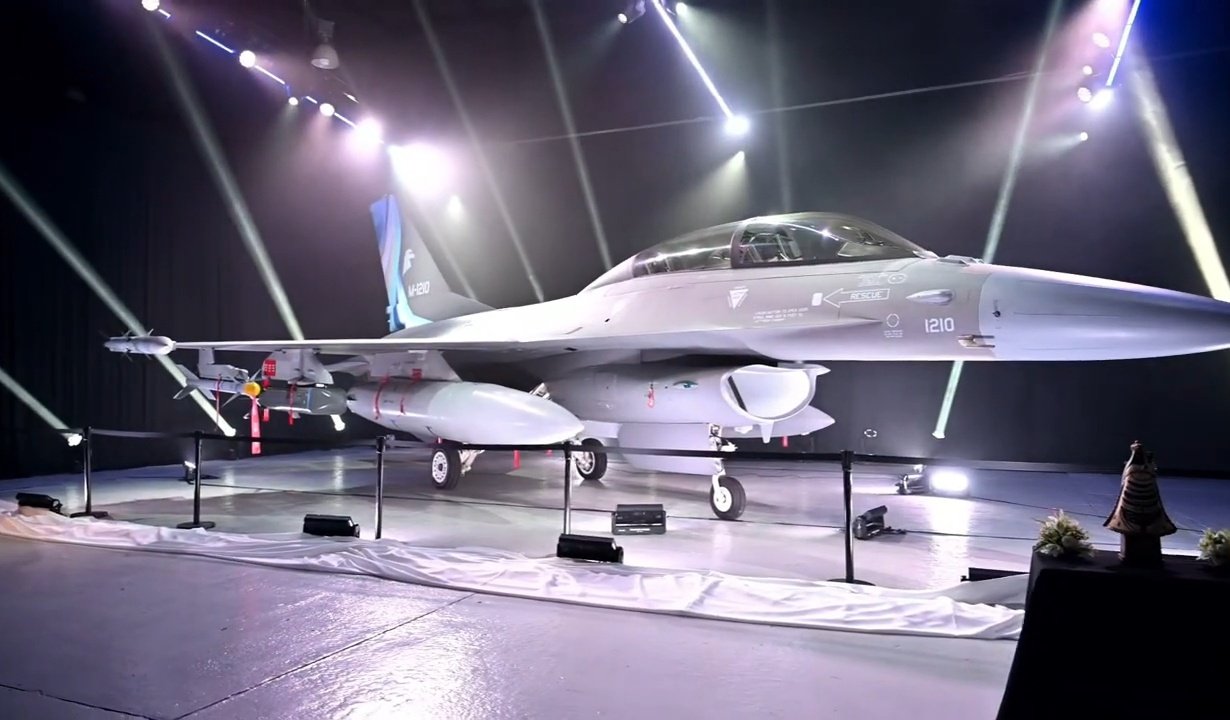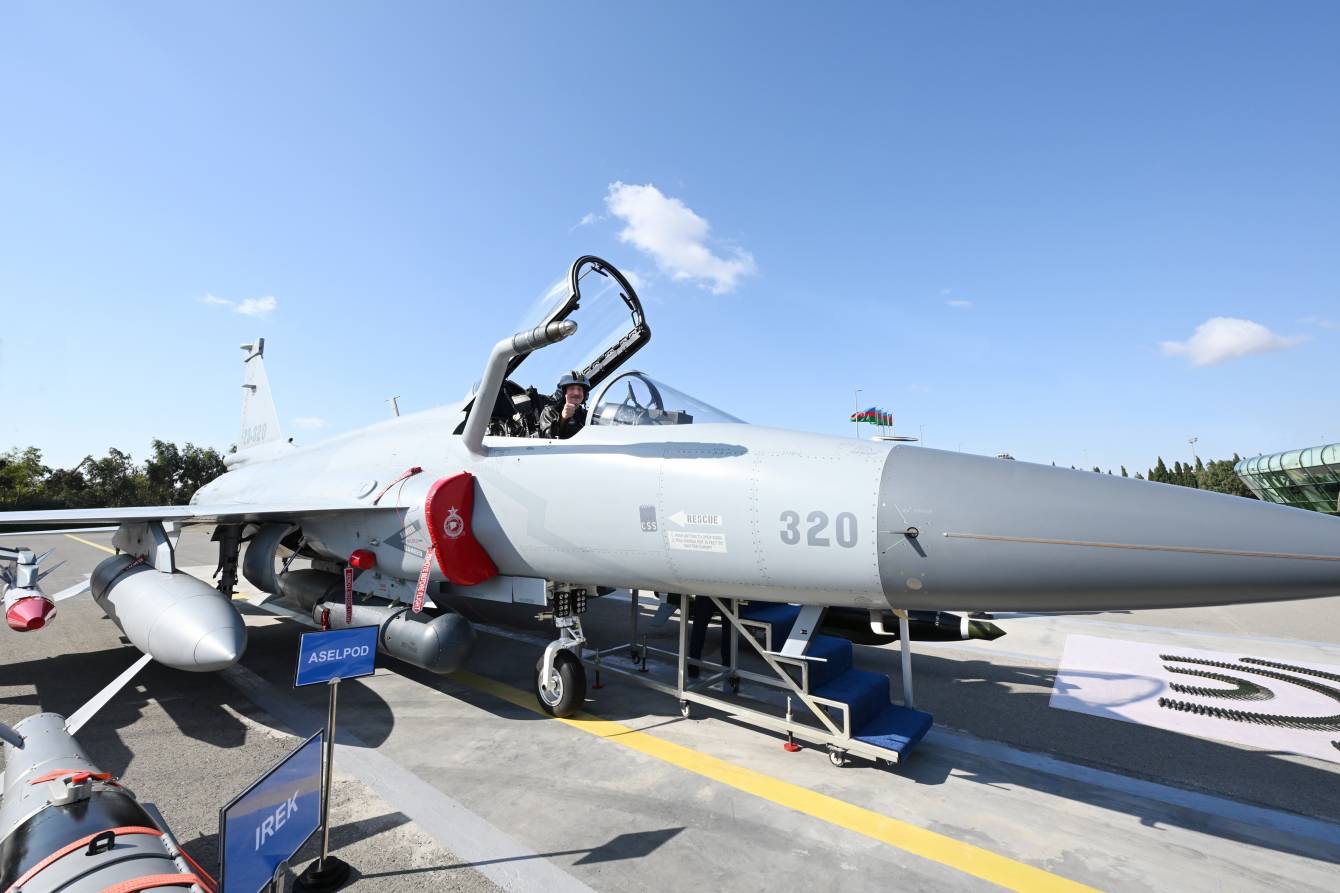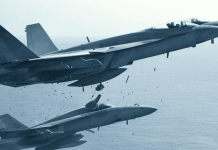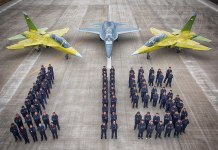Argentina has unveiled its first F-16 Fighting Falcon at a ceremony attended by government officials months after it announced the decision to buy the second-hand aircraft from Denmark instead of the brand-new Chinese JF-17 Block III Thunder.
The aircraft acquired from the Royal Danish Air Force was reportedly unveiled at the Tandil Air Base in Buenos Aires on the night of February 24. The aircraft displayed publicly is an F-16BM with code designation M-1210. It was equipped with AIM-9 Sidewinder and AIM-120 air-to-air missiles and a stand-off weapon for precise ground strikes.
The aircraft has been integrated into the VI Air Brigade of the Argentine Air Force (FAA), which previously hosted the Mirage III fighters. The FAA believes that the Fighting Falcon represents a massive technological leap for a country that has been without a capable combat jet for several years.
The two-seat aircraft unveiled at Tandil is not airworthy and would only be used to provide ground training to the FAA personnel. The FAA will receive the rest of the 24 second-hand jets in the coming months, with deliveries expected to conclude by the end of next year.
The jets’ final assembly and integration will reportedly take place at the FAA Material Park in Río Cuarto, in the province of Córdoba.
It is noteworthy that the first delivery comes almost ten months after Argentine President Javier Milei and Defense Minister Luis Petri disclosed in April 2024 that Argentina had finally sealed a deal to purchase two dozen second-hand Danish F-16 Fighting Falcons for about US$300 million.
Denmark has retired the F-16 fighters in its arsenal in favor of the F-35 Lightning II stealth fighters. It earmarked 19 of these fighters for Ukraine (most of which have been delivered) and sold the rest to Argentina, which had been desperately looking for a capable fighter jet to replace its archaic A-4 Fightinghawks.
This came as a breather for Argentina, whose efforts to acquire a cutting-edge combat aircraft were impeded by its precarious economic position and a blockade imposed by the United Kingdom.
Over the years, Argentina tried to buy many different aircraft, including the Dassault Mirage F1, IAI Kfir, Korea Aerospace Industries’ FA-50, and the Saab Gripen NG. However, all these deals were made to fail at the behest of the UK (due to the ‘dispute’ over Falkland Islands).
This is one reason why the country has hailed the acquisition of the F-16 as pathbreaking. Argentina has grown closer to the US since Javier Milei took office.
It is nonetheless intriguing that Argentina decided to purchase a used, older-generation F-16 Fighting Falcon over a brand-new advanced combat jet—the JF-17 Block III (jointly developed by China and Pakistan).

The decision came as a massive surprise for China, which was optimistic about a potential deal with Argentina. In fact, the Argentina Embassy in China announced on March 14, 2024, that the South American nation was seriously considering the JF-17 fighters.
The Argentine government’s final decision was ostensibly influenced by the United States, which did not want a Chinese aircraft in its backyard. The US also allegedly took the UK in confidence and convinced it to let the strings loose so a deal could be signed between Denmark and Argentina.
The Older F-16 Trumped JF-17 Block III Thunder
Argentina’s acquisition of the F-16 has been hailed as the commencement of a new era for the country’s security. However, it cannot be discounted that the purchased F-16 is an archaic aircraft that may not be best suited for modern air combat, as seen in Ukraine, where the aircraft has been used only in a defensive role.
When asked whether the aircraft threatened Falklands Island, where the UK and Argentina fought a war in 1982, British experts said they were confident of the aircraft’s ineffectiveness.
For instance, writing for the UK Defence Journal last year, military expert George Allison stated that although Argentina’s acquisition of F-16 fighter jets may seem like a major military advance for the country, the South Atlantic scenario remains mostly unchanged. He emphasized that “the ongoing challenges of obsolete equipment, insufficient resources, and diplomatic limitations persist in hindering progress.”
This brings attention back to the JF-17 Block III fighter jet, which was rejected in favor of the F-16. Unlike the F-16A/B (Block 15) acquired by Argentina, which is the aircraft’s initial model, the JF-17 Block III is the latest and upgraded variant of the lightweight, single-engine, multi-role aircraft developed by China and Pakistan.
While combat-tested, the F-16 is now being retired by air forces globally in favor of more advanced aircraft. The F-16 has been upgraded multiple times over the years, with Block 70/72 (also called Viper) being the latest F-16 produced by Lockheed Martin. Countries that have an aging fleet of F-16s, such as Turkey and Taiwan, have been making concerted efforts to upgrade them.
Against that backdrop, the decision to acquire a second-hand, old aircraft certainly appears bold. The Danish F-16A/B acquired by Argentina had earlier received a Mid-life upgrade to keep it operational.
In contrast to the F-16, the JF-17 Block-III variant that was offered to Argentina has advanced avionics, electronics, flight control systems, and an active electronically scanned array (AESA) radar.

It can also fire Chinese air-to-air missiles like the PL-10, PL-12, and the PL-15. Additionally, from a techno-industrial, commercial, and tactical standpoint, some experts suggested that the JF-17 could have better served Argentine needs.
This JF-17 Block III can be used in various combat scenarios. It is capable of carrying various weapons, including air-to-air and air-to-surface weapons, guided and unguided bombs, and anti-ship missiles. It has also been equipped with a PL-15 Beyond Visual Range (BVR) missile, which has a range of 300 kilometers.
Due to its lower radar cross-section, the JF-17 Block III has better stealth characteristics than the F-16A/B.
The JF-17 Block III aircraft boasts an active electronically scanned array (AESA) radar. Reports state that the aircraft is equipped with the KLJ-7A airborne active electronically scanned array (AESA) fire-control radar. Additionally, the JF-17 Block III has several notable improvements, including Missile Approach Warning Systems (MAWS), an integrated electronic warfare (EW) suite, a Wide Angle Smart HUD, and additional hard points.
The above features are missing from the F-16 purchased by the Argentine government. Additionally, the JF-17 Block III aircraft is not too expensive, priced at just between US$15 million and US$25 million each, considerably cheaper than every other fourth-generation jet in the market.
Despite that, the F-16 remains relevant to this day, according to the United States, which kept harping on the fact that the F-16 is a battle-proven platform with a high availability of spare parts. While the Argentine jet belongs to the first version of the aircraft, it can undergo modernization.
According to the US Air Force, “In an air combat role, the F-16’s maneuverability and combat radius (distance it can fly to enter air combat, fight, and return) exceed that of all potential threat fighter aircraft. It can locate targets in all weather conditions and detect low-flying aircraft in radar ground clutter.”
- Contact the author at sakshi.tiwari9555 (at) gmail.com
- Follow EurAsian Times on Google News




